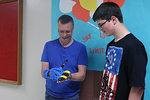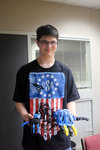

An eighth-grade student at Centralia Middle School has put his science skills to the test in order to help those in need by creating simple prosthetic hands using the after-school program’s 3D printer.
Dylan Altona, 14, has created three of the prosthetic hands using a design by e-NABLE, a global community with a goal of making affordable prosthetic hands for people who need them.
The first hand Altona created was for practice, the second one was designed for a 6-year-old, and the third was for Mark Westley, a math teacher at CMS, who is an amputee.
Mixing his love of science and his will to help others, Altona plans to make one more hand before the year’s end.
“I wanted to be helpful to others and possibly have something good on my resume,” Altona said. “It feels good.”
The hand designed for the dimensions of a 6-year-old will be sent to e-NABLE to see if it meets the company’s standards. If it does, the company will put Altona in contact with a child who could use the hand, said Nikoe King, 21st Century site coordinator for the after-school program.
As for the hand for Westley, Altona hopes it will make daily tasks easier for the teacher.
Westley was involved in a house fire accident in 1973 in Centralia. At the time, he was 9 years old and suffered extensive burns to his face, arms and legs. The accident resulted in a traumatic amputation on his right hand, and some amputation to his other hand as well.
This will be the first time Westley has used any type of prosthetic.
“I’ve used an adaptation and always dealt with what I had,” he said. “Part of the excitement with me for this one is it’s the first time I will experience anything with a prosthetic.”
The hand for Westley is not yet complete. It still needs to be equipped with tension equipment to move the digits, and padding and velcro to keep the hand in place.
“It’s pretty exciting to have that capability in our school system now for the robotics club to be able to get that as part of our regular curriculum to give students who have that interest just another opportunity to be able to open the door for their advancement and their education,” Westley said.
“Just to be able to be in a position where I can be a live model for them to be able to actually see that application instead of just in theory, that makes it pretty exciting.”
King said the 3D printer, which the after-school program obtained in August 2015, helps students gain experience.
“It gives them real life experience at creating things and being able to make a difference even though you are in middle school; I think that is huge,” she said. “What will be better is when we can actually see Mr. Westley use it and if it helps him.”
Altona said the hand designed for Westley is a heavy-duty model equipped with metal screws for more durability.
With an interest in engineering, Altona plans to continue studying robotics in high school. He’s decided to take a metal class and robotics to further his skills.
The teen is already further along than many in the after-school program, utilizing different software that is more complex and provides additional opportunities to create three-dimensional objects.